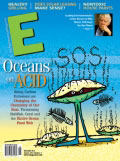The World’s Waters Are Becoming Corrosive to Critical Marine Life. Is Time Running Out to Save our Oceans?
The oceans do a lot of the Earth’s dirty work. On a given day, they will absorb 22 million tons of carbon dioxide (CO2), a third of the global output. In doing so they help to keep climate change in check, but they also pay a heavy toll as a result.
Increasing levels of carbon in the ocean are making the water more acidic, and that’s beginning to have an impact on shellfish, corals and some of the tiniest shell-making marine organisms that are essential to the ocean food web. The June 2012 issue of E – The Environmental Magazine (now posted at www.emagazine.com) takes a closer look at the phenomenon of “ocean acidification,” the process by which levels of CO2 are rising, changing the chemistry of the ocean, and the ways this is impacting sea creatures on which mankind depends.
Shellfish farmers in Washington and Oregon were some of the first to sound the alarm about ocean acidification. In 2006, hatchery-produced oyster larvae began to die off, despite their controlled and monitored environments. The two largest oyster hatcheries — which supply seedling to the majority of West Coast oyster farmers — lost between 60% and 80% of their larvae. Through ocean monitoring, the farmers discovered that the pH had fallen enough to make the water too corrosive for the oysters to form shells.
Once the problem was identified, shellfish farmers were able to take precautions — such as waiting to fill tanks following a north wind when upwelling causes corrosive water to rise to the surface. But in the open ocean, there are no quick fixes for ocean acidification.
“A lot of things we like to eat have these calcium carbonate shells and they’re very sensitive to acidification,” says Richard Feely, Ph.D., a senior scientist with the National Oceanic and Atmospheric Administration (NOAA) and its Pacific Marine Environmental Laboratory (PMEL). “Just a small drop in pH can cause the shells to begin to dissolve. It turns out that for many of these species, the larval and juvenile stages are much more sensitive than the adults. And we’re finding that they can die off quite rapidly even with the kinds of changes that we’re seeing right now.”
One of the most serious threats posed by ocean acidification is to corals — marine animals that need carbonate ions to form their skeletons. During ocean acidification, CO2 sinks into the water and releases hydrogen ions which combine with carbonate ions, making them unavailable to the shell- and exoskeleton-making creatures that need them.
“There have been a lot of studies showing that under ocean acidification scenarios corals and other organisms on the reef calcify at a slower rate,” says Davey Kline, Ph.D., a coral reef ecology expert at the University of Queensland in Australia. “Even with just a little less growth, the corals can be tipped into these situations where they’re getting eroded faster than they can grow and the reefs start to dissolve.”
Coral reefs are already at risk from pollution, development, overfishing and warming waters as a result of global warming. Ocean acidification may be the final stressor that pushes them into extinction. The most recent report on reef health — Status of Coral Reefs of the World: 2008 — found that 19% of coral reefs were already lost, 15% were in a critical state with loss possible within a decade or two, and 20% could be lost in 20 to 40 years. “If we continue on the trajectory that we’re currently at,” says Kline, referring to unchecked global emissions, “we will lose reefs as we know them.”
The impacts of a world without reefs would be profound. The estimated net global value of reefs is $29.8 billion per year, and reefs provide essential work in protecting shorelines from storm damage, providing a home to one million species and offering new sources of medicine to treat everything from cancer to arthritis.
There are certainly local solutions, including designating marine protected areas to at least minimize the stresses on coral reefs in light of global warming and ocean acidification. But any major solution to keeping ocean acidification from further threatening our oceans and its inhabitants needs to involve a global agreement for keeping emissions in check — something that, despite the warning signs, seems oceans away.
————————————————————
E – The Environmental Magazine distributes 50,000 copies six times per year to subscribers and bookstores. Its website, www.emagazine.com, enjoys 150,000 monthly visitors. E also publishes EarthTalk, a nationally syndicated environmental Q&A column distributed to 1,850 newspapers, magazines and websites throughout the U.S. and Canada. Single copies of E’s May/June 2012 issue are available for $5 postpaid from: E Magazine, P.O. Box 469111, Escondido, CA 92046. Subscriptions are $19.95 per year, available at the same address.








